Unless this circuit is being operated with a voltage source with frequency in the megahertz or more, there's not much point in analysing what happens to actual charges here.
You can rely on Kirchhoff's Current Law to tell you everything you need to know about this circuit, and yes, it works for capacitors too. If you insist on talking about charges, let me assure you, that if one single electron enters one side of a capacitor, then another exits the other side. If that happens to the top capacitor in your diagram, you now have a greater charge density at A than before, and the change in potential that causes would simply push the electron right back in again.
Because current in equals current out, and because there is "infinite" resistance to current flow out of A, no current flows in that top capacitor, and you can consider it to be entirely absent. Consequently, all that remains is the other capacitors in series.
As far as charges entering and leaving the voltage source are concerned, one thing is certain; no electron that leaves that source can ever return to it "in person" because there are dielectric barriers in the capacitors, which the electrons cannot traverse.
This should tell you that the electrons entering the voltage source must already be present in the wire connected to it. I'm alluding to your idea that charges accumulate in wires, which is not the case. They are always there. Like when you switch on the tap in your bathroom, water emerges immediately, because water was already in the pipe. If the pipe was empty, sure, you would have to wait for the water to arrive from the tank, but that's not how electric current works. Charges are always present in conductors, it's simply not possible to "empty" them of charge.
What I just said is true, but capacitors seem to act differently. It is possible to remove charges from a plate, but as you do, more charges will be drawn onto the other plate as a result. The total quantity of charges on both plates of a capacitor doesn't change, but their distribution within, does. This is why I can say that if charge enters one capacitor terminal, then the same amount of charge must necessarily leave out of the other terminal. Current in equals current out, in accordance with Kirchoff's Current Law. All that has changed, really, is the distribution of charges on the plates of the capacitor, and no charge ever crosses the dielectric.
So, I reiterate, since by Kirchhoff's Current Law we see that no current can flow out of the capacitor to node A, no current can flow into that capacitor, and it can be disregarded. If for some reason charge made it out of the capacitor into node A, this would disturb the equilibrium of charge distribution within that node, and the resulting change in potential would simply cause the equilibrium to restore itself, pushing charge back into the capacitor.
Of course, charges are moving all the time, mainly due to kinetic energy which we call "heat", so what I am describing here is an "average" behaviour of trillions of charges. Sure a few might move upwards towards A, but they will displace another bunch back down again, so on average, there's no current flow.
So, ignoring individual charge behaviour, en-masse they behave in such a way that it is simply not possible for charges to enter anything without an equivalent quantity also leaving, which may or may not be the same actual charges. When you charge a battery, there are not more electrons in it now than there were before, they are simply distributed differently with the battery. Current in always equals current out, and that's Kirchhoff's Current Law (KCL) in a nutshell.
Edit: I'd like to say also that when people refer to "charge accumulating in a capacitor", that's misleading. Accumulation of charge on one plate results in an equal depletion of charge on the other, so there's no net accumulation; only a change of distribution.
Also, just to drive the point home, within a section of wire, there are a certain number of electrons which are mobile, and can participate in "electric current". That number doesn't change, whether current is flowing or not. When a million electrons are pushed in one end, a million are shoved out of the other end, the total number occupying the wire section never changing.
You should discard the notion that charge "builds up" anywhere, except under very particular circumstances. For example, a FET's gate may accumulate electrons, but that will simply expel electrons in the channel, forming a depletion zone. From the perspective of an observer outside this FET, though, KCL was obeyed, because those expelled electrons will manifest an equal charge flow out of the drain and/or source. In other words, even though individual devices may rely on some imbalance of charge distribution within them, their net charge content does not change. To the engineer outside, no imbalance would be visible, and no violation of KCL would occur.
